Few Fine Art Photographs Are Sold Today True False
When the globe saw the very first photographs, the thought of being able to capture the world as we see information technology took off rapidly. In a relatively brusk period of fourth dimension, film photography evolved from black and white to color photography. From there, information technology fabricated move pictures possible, assuasive us to come across the world from our couches at home. When the first digital camera was invented, petty did the inventors know that information technology would after revolutionize the earth of photography and media in full general. Today, billions of images are captured and shared betwixt people and the number of image recording devices is growing at a rapid, unstoppable rate. There are cameras literally everywhere – in our mobile phones, homes, computers, cars and even in wearables like eyeglasses and watches. We trust these devices to requite us a glimpse of reality, documented moments of time that we can go back to and review. And yet with the fast growth, ease of admission and use of paradigm and video manipulation tools, we have been seeing more footage that can twist reality: whether nosotros are looking at pop mag covers, Cyberspace sites or news media, the imagery we encounter is getting harder and harder to trust, since information technology is beingness altered, faked or staged. Media turned out to be a powerful tool to influence and manipulate people, which brings up the question and the importance of ethics in photography. Should photography only be allowed to display reality, or is it acceptable to modify images for presentation purposes? And if manipulation is acceptable, what are its limits, if any? These are very hard questions to answer, but with some common sense, nosotros tin create a set of ethical rules and guidelines that should assist photographers in determining what's acceptable and what's non.
In this article, I exercise not want to get into the depth of the give-and-take of ideals in media, since information technology is a huge topic on its own and does non belong to a photography site. Instead, I will focus on specific types of photography and the practices we should follow. Please go along in mind that well-nigh of the thoughts in this article are based on my opinion and experience. If you disagree with any of them, please state your thoughts in the comments department below in a kind thing, then that we can take a friendly discussion that benefits everyone.
Table of Contents
1) Image Theft
With billions of photographs being bachelor so widely all over the Internet, it is not uncommon to see not just individuals, just also companies using other people's work for their own benefit. In some cases, theft is loud and articulate, with images existence used without any permission; and in other cases, images are "borrowed" to be altered and manipulated to create something unlike. No matter how it is washed, theft is still theft and information technology should not be ever welcomed in whatsoever shape or class. How would you feel if someone stole your images that you lot post in common social media platform like Instagram, printed them out and sold them for thousands of dollars without sharing whatsoever of the money with you? If you accept never heard of Richard Prince, check out his website and his gallery:
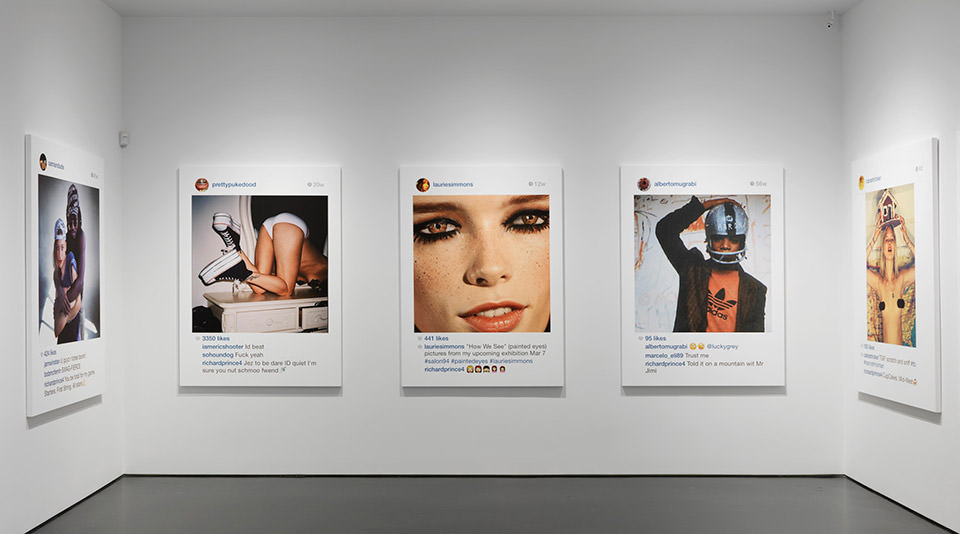
Yup, he does exactly that: steals other people's work, prints them and sells as his own "artwork". One could argue that he "repurposes" some of the images and that may be true in some cases where he significantly transforms an prototype to something completely different. But even and then, he should be requesting permission from the original source kickoff and even later on receiving permission, he should clearly state in his artwork that his work was based on someone else's idea or images. The worst role is, some people (including himself), believe that he is a true creative person and he has every right to practise what he does. In my books, this guy is nothing more than a thief!
2) Photo Plagiarism
What about situations, where a photographer borrows some other lensman'southward idea and perspective to get a very similar, if not identical shot? Now this one is a topic of endless debates, 1 capable of sparking huge arguments on both sides of the game. As photographers, we often have our own knowledge, skills and experiences to create something unique that has never been done before, at least to our knowledge. It could exist finding a particular bailiwick, angle, composition, subject placement, or perhaps specific utilize of colors and tones to create something original. Is it acceptable to re-capture such images, taking inspiration from the original writer? And if information technology is adequate, should permissions be asked and credit provided? I retrieve the answer depends on a number of factors. If an image is copied exactly one-to-one, using the aforementioned angle, perspective, composition, subject and colors, making information technology await identical to the source, then it is a clear sign of plagiarism and information technology should never be welcomed.
However, in that location are certain exceptions. For example, in landscape photography (covered in detail below), there are situations when one photographer can find and popularize a unique spot where certain angles and shapes piece of work very well. Throughout history, at that place have been many such images – for example, Ansel Adams made the Snake River overlook very popular at the Grand Teton National Park:

Copyright Ansel Adams, Image Source: Wikipedia
And since so, endless images have been taken with a very like perspective and angle by other photographers. Does it hateful that they should be crediting the source every single time? This is a hard question when information technology comes to ideals, because landscapes alter all the time and if one lensman does manage to capture an paradigm one way, chances of capturing some other paradigm with exactly the aforementioned lite, cloud formation, vegetation and color are fairly slim, even if exactly the same limerick is used. In the case of the above photo from Ansel Adams, since he has captured the shot at the Chiliad Tetons, many trees take grown and fallen and even the snake river most likely slightly changed its shape and looks a bit different today. Does it mean that other photographers should non be taking the shot with a similar composition? I don't think so – I believe it is perfectly adequate for others to capture images of popular spots, provided they are not deliberately trying to make an exact replica of the shot of the original author, with the intent to re-create it. At present if someone edited the trees to wait exactly like the ones in Ansel Adams' original shot, turned it into black and white with the same aspect ratio, similar shades and deject formations, then it could be considered as deliberate plagiarism.
Even so, landscape photography almost feels similar a different beast when it comes to plagiarism. While using the same subject, perspective and composition are often acceptable in landscapes, attempting to do the aforementioned thing in other types of photography, such every bit portraiture and fashion photography, is an inevitable path to plagiarism. For example, if nosotros await at the piece of work of Tyler Shields, nosotros can see many of his images were borrowed ideas from other existing works. Take a look at some of the examples:
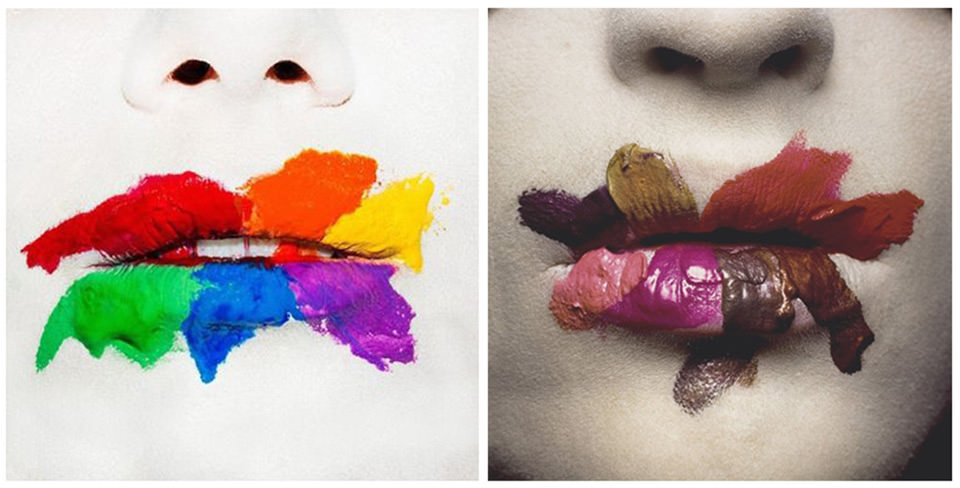
Image Source: Vice.com
In this prototype, nosotros can clearly encounter that Tyler Shields attempted to copy the work of Irving Penn, by making a very similar prototype. The idea is the same, the crop is the same. Still, he did change a few patterns, adjusted colors and made a slightly different epitome. Does information technology mean that his work is original? Of class not – it was clearly based on someone else's work. At that place is nothing original near this slice. And even so Tyler Shields never credited Irving Penn for inspiration in creating this photograph. Allow's take a look at a dissimilar image of Tyler Shields:
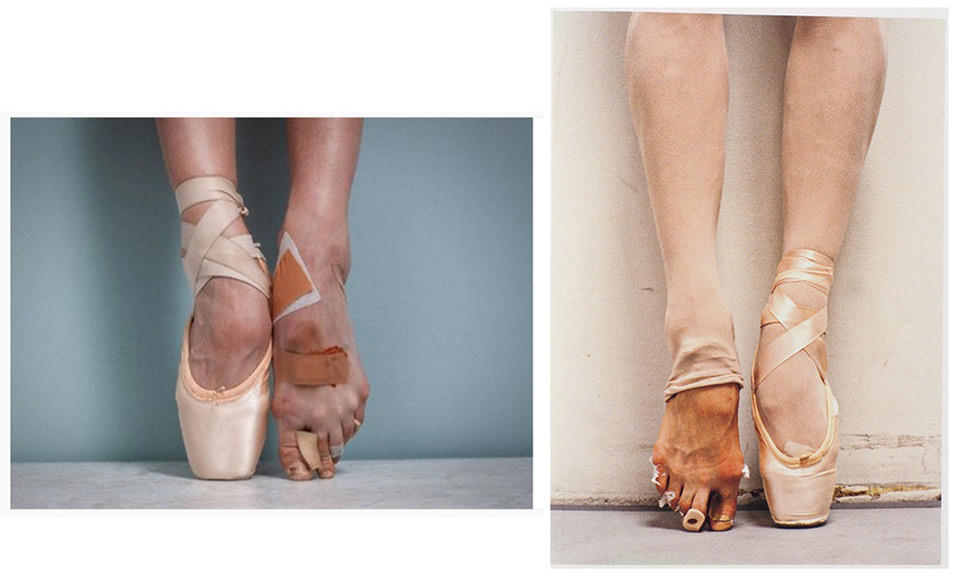
Image Source: Vice.com
We can clearly run across the pattern of a copy-cat. Once more, the same idea of hobbling legs of a ballerina standing straight up and only showing the affected area. One side has a shoe, the other does not. He attempted to brand his work appear different and original by swapping the shoe, having different bandages and bruises, but nevertheless, it is withal not an original idea past whatsoever means. In this instance, if Tyler Shields used Henry Leutwyler's work for inspiration, he should have given him proper credit.
In some cases, images tin can indeed await very similar past coincidence. And when information technology does happen, it would be truly a "one-off" case. However, if you lot expect at the many works of Tyler Shields, you will see that the above are not cases of coincidence or sheer luck. He deliberately borrowed other people's ideas and executed them in a similar style to make a name for himself.
Sadly, in the world of social media, plagiarism is about inevitable. Photographers steal ideas from other photographers all the time and some exercise a very good task at information technology too, often succeeding more than the original author, as in the example of people like Tyler Shields and Richard Prince. In that location is nothing ethical about what they do and I would discourage all of our readers from repeating the same mistakes…
3) Photo Manipulation
Allow'southward at present aggrandize the topic of ideals in photography to photograph manipulation. How much manipulation should be allowed and what are the limits? Photography purists will argue that photographs should never exist altered in any manner – that they should retain their originality. Some fifty-fifty contend that cropping should be a prohibited practice. On the other side of the farthermost, nosotros've got people who take no shame in severely manipulating images, sometimes in order to influence people's minds, alter their perceptions or their opinions. Is there a sweet heart that satisfies photography ideals? I believe there is, but it is not an easy answer past any means – nosotros need to look at each photography genre in detail, as it is a very complex topic.
3.1) Documentary, News and Reportage
Today, news outlets rely more than they ever accept on images and footage provided by the public. Although the almost popular media outlets try to have their own staff provide media, it is not always possible, particularly in areas of conflict and inaccessible war zones. When the public sees such footage, there is an immediate level of trust in what they see. Every bit a outcome, such content can play a huge role in shaping up public stance, potentially even influencing their time to come decisions. Because of the importance and the potential influence of such documentary footage, it is only upstanding when such imagery is provided without ANY manipulation any.
This includes documentary photography, news and reportage of any kind, which in my opinion also includes street photography. When we run across images of people, afflicted or unaffected, we want to believe in what we see. Such images get historical records and we cannot permit them to be manipulated. Take a look at some of the altered images that have appeared in media in the past:

At the time the image was taken, it was probably unacceptable for the Iranian state media to present merely three missiles in the air, with i looking similar it failed to launch, so the image was altered in Photoshop to get in look like all four rockets took off. In addition, a smaller automobile seen behind the rocket launching vehicle was as well removed from the image to remove the unnecessary distractions.
Here is another image by Brian Walski, which was heavily altered to make a single blended from ii different images:
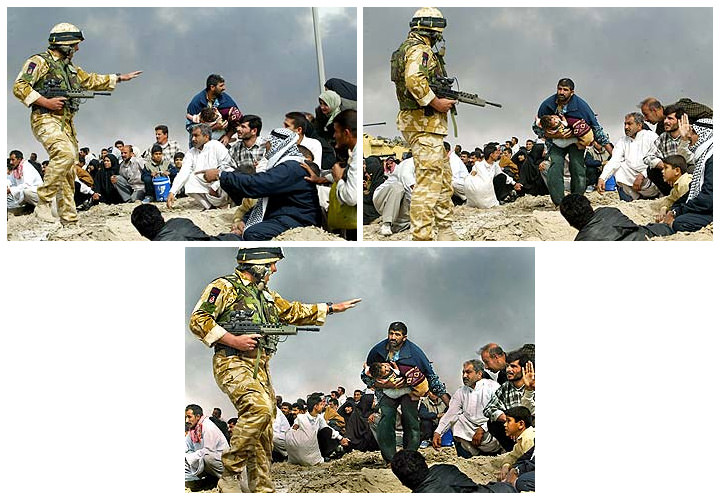
Sadly, Brian Walski thought that it would be a expert idea to make a blended image from the two images to "improve composition" and thought it was acceptable for him to make such heavy edits. In some cases, people that exercise such manipulations should be persecuted in court, especially if a photograph is used every bit any grade of propaganda to prevarication about the actual facts.
We tin can see many examples like the above two all over the world. If you want to see some of the best examples of altered images in history, check out this website by the Bronx Documentary Middle – you will find some shocking examples of altered images, some of which were used to manipulate the public.
It is clear that such documentary photography and footage should never be allowed to be manipulated. The skilful news is, those who go defenseless often get fired and potentially fifty-fifty jailed for doing it, simply I bet there are far more cases where things become by unseen. If photographers destroyed their original images and only left the original footage, they would exit it up to public to decide whether their work is accurate or not. It is very uncomfortable to call back that people would do such things, only sadly, it does happen.
What about cropping images? I believe that cropping should only be immune, if the cropped out area does non correspond expanse of interest to the viewer and does not change the pregnant of the photograph after the fact. This tin can exist tricky to make up one's mind, so if there is even a slight dubiety that cropping would modify the bulletin in whatsoever manner, and so it should exist avoided at all costs.
3.2) Portrait and Mode Photography
Portrait photography, and specifically manner photography, is without a doubt 1 of the most Photoshop-influenced genres of photography today. Practically every image yous look at today on the cover of every magazine is digitally altered. In some cases, changes are very subtle, but in most cases, people become through complete transformations, making them await drastically different compared to the reality. Such retouching changes are so common today, that they are now widely accepted as a "normal" practice to make the model or glory look flawless. And so where is the fine line between what should be considered upstanding and what should not? That's another tough one to answer, because at that place will exist people defending both sides heavily.
Personally, I believe that retouching should exist acceptable, but with certain restrictions. While adjusting colors & contrast, fixing skin blemishes, removing excessive hair and taking care of wardrobe mishaps should be allowed, altering someone's physique and general appearance should be prohibited. Consider the following photograph of Angelina Jolie:
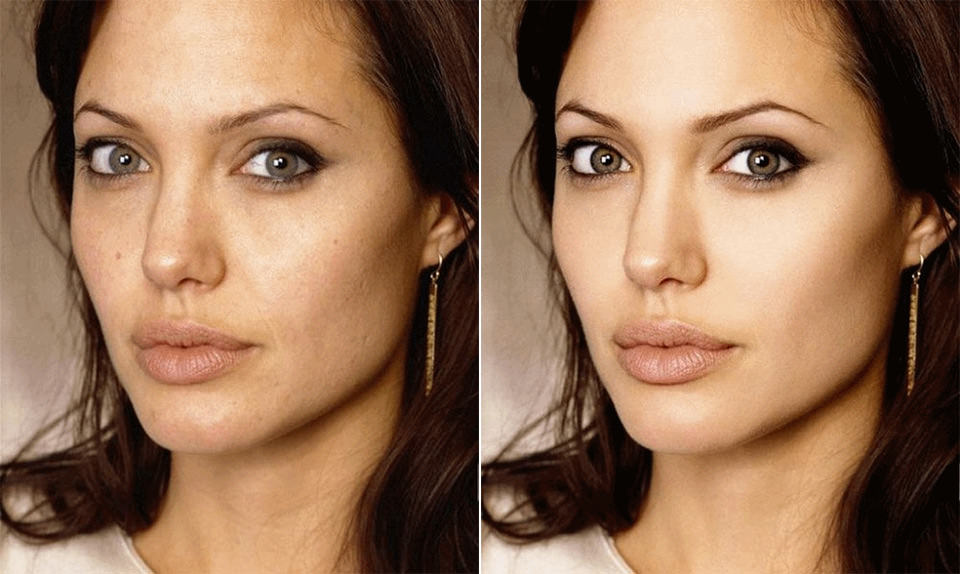
To me, this is the borderline of what should exist immune. The retoucher removed all pare blemishes from her face and made the peel of the actress look flawlessly polish, which as we know, is virtually never the case. However, facial features do not seem to be drastically contradistinct, as in the below image of Kelly Clarkson:
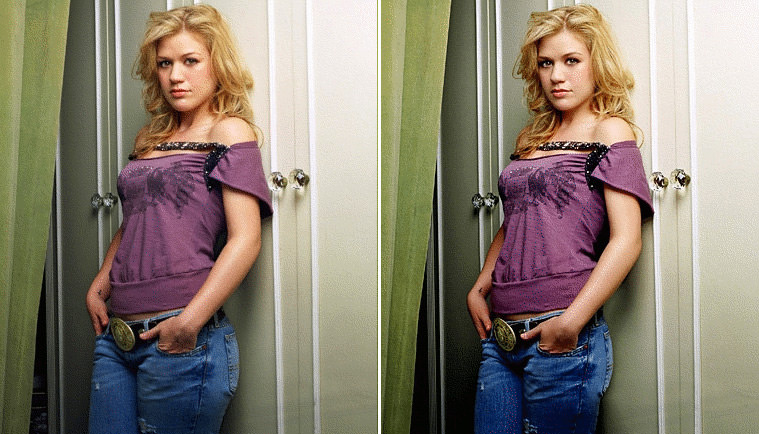
Here, the retoucher went to the extreme – eyebrows and eyes inverse, face shape altered, body shape altered, peculiarly towards the lower body. This is an example of heavy retouching that should non be allowed. This kind of imagery takes the states away from the reality, making our youth believe that people can look as perfect as they exercise in the mag covers. These are not the ethics to pursue and this kind of "false" beauty should not be welcomed by the public.
Having assisted my wife in photographing weddings, I accept come beyond a number of brides, bridesmaids and other people, who fabricated special requests to brand them look thinner in photographs via Photoshop. Although my wife certainly did experiment with such capabilities and knew very well how to employ specific tools such every bit "Liquify", she establish it quite frustrating to concur to such requests. Not only because information technology is a lot of work, but also because it is just not correct – people should not assume that such practices should be ordinarily acceptable. Overtime, she learned how to position the subjects better and capture them at particular angles that made them look slimmer, only she completely stopped heavy digital manipulations that fabricated the person look dissimilar than they were in reality.
3.iii) Nature Photography
Humans are drawn past the sheer beauty of wild and mysterious nature. Having witnessed it in existent life, we know that nature tin nowadays itself in vibrant and cute colors especially during those peak golden hours, and at the same time can really impact our moods with those gloomy, cloudy days. And then when we immerse ourselves in a photo with a stunning mural, we ever make the assumption that nosotros see the reality: nosotros desire to believe that the photographer was there at that right moment of time to capture the natural dazzler. While we tin can make assumptions about the fake nature of photographs of celebrities in magazines, we practically never make such assumptions on images of nature. Why is that? I have been pondering about this question for a while and I think the answer to the question is quite simple – we want to believe in nature being as beautiful equally it is presented to the states. We look at nature as something raw, innocent, something that has not been corrupted by the humanity.
The moment we are introduced to a nature photograph that conspicuously looks unrealistic, or worse still, when we notice that a photograph that we perceived equally real was in fact non, it leaves us with a feeling of distrust towards the photographer. We experience cheated and faked.
Take a look at the 2 images below, one straight out of my camera, and one after I slaughtered the hell out of it in Photoshop:
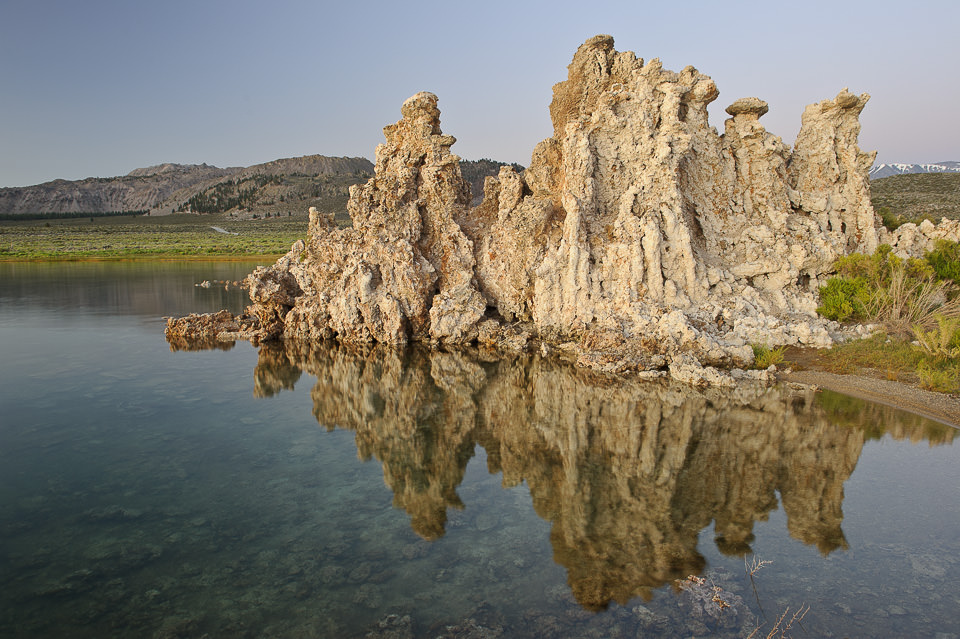
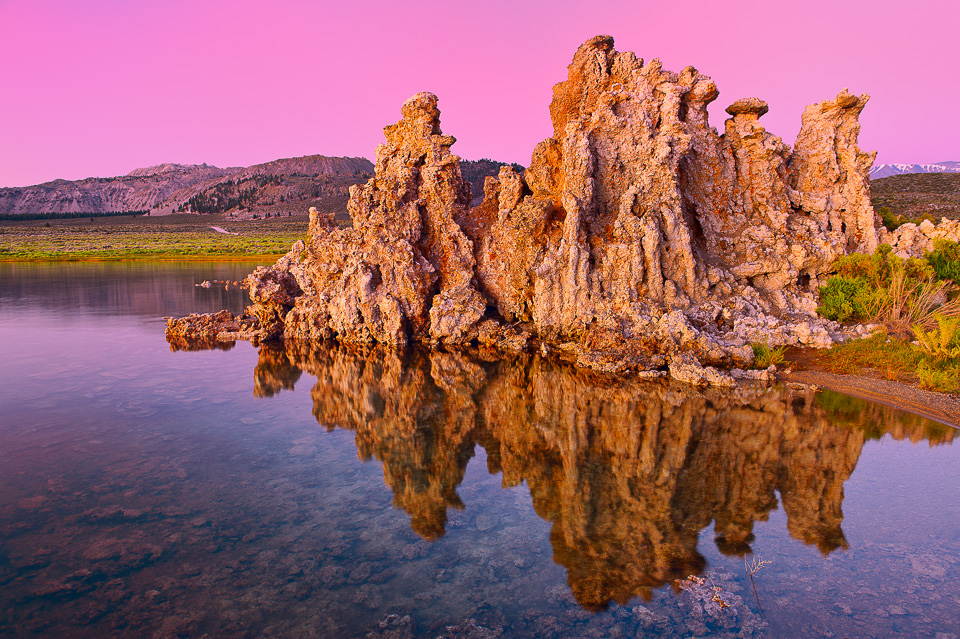
Five years ago I thought that my edit looked "cool and dramatic", although I knew upfront that information technology looked very fake. Without moisture or cloud formations in the air, the sky could have never be that colorful! And still at the time, I thought information technology was a cool effect to use on an image, giving it more of an "artistic" experience. I often make fun of myself with this detail photo in my workshops, because I want others to see that we all go through the stages of experimentation and it is perfectly OK to try out things. I would never brand this image as part of my portfolio and would never present it in a gallery, because it skews reality and presents nature in its well-nigh unrealistic course.
Here is another prototype that actually upset some of our readers when I posted it:

Although it is pretty clear that the epitome is a composite, people got really upset that I re-create-pasted the different phases of the moon to a completely unlike scene. For this composite, I photographed the moon on its own, then moved to another location after the eclipse was over in order to capture a more than attractive foreground, which I later used equally a backdrop panorama for the arcing moon. I wrote about what I did to the image in particular in my "how was this picture made" article, where I explained the process in detail, for the purpose of teaching. The above epitome is not something I would ever claim as existent – in fact, I purposefully fabricated it look fake (the moon never arcs like shown in the image), and so that it was articulate from the image itself. This is another image that I would never display at a nature gallery, considering nothing most it represents the reality. Sure, the moon phases are real, the landscape is real, but the two never took place together as shown in the image.
So what kind of editing is ethically acceptable in nature photography? That's the million dollar question and the can of worms to open! In mural photography, I consider information technology acceptable to arrange exposure, colors, shadows, tones and dissimilarity, to perform selective boosting / dodging and burning, to crop images for better composition and to perform other adjustments, equally long as they don't brand the image appear likewise unrealistic and fake. I am not confronting HDR photography either – in fact, it can be a slap-up technique to use in order to recover data that cannot be otherwise captured past mod camera sensors, as long every bit it looks natural at the end (no Grunge HDR please!). I am non against blending techniques to bring out details from unlike parts of the scene either, as long as they are not overdone. Lastly, I also observe it adequate to remove distracting objects from the scene. Basically, I don't mind most types of editing!
Here is an example of the blazon of editing that I find acceptable:
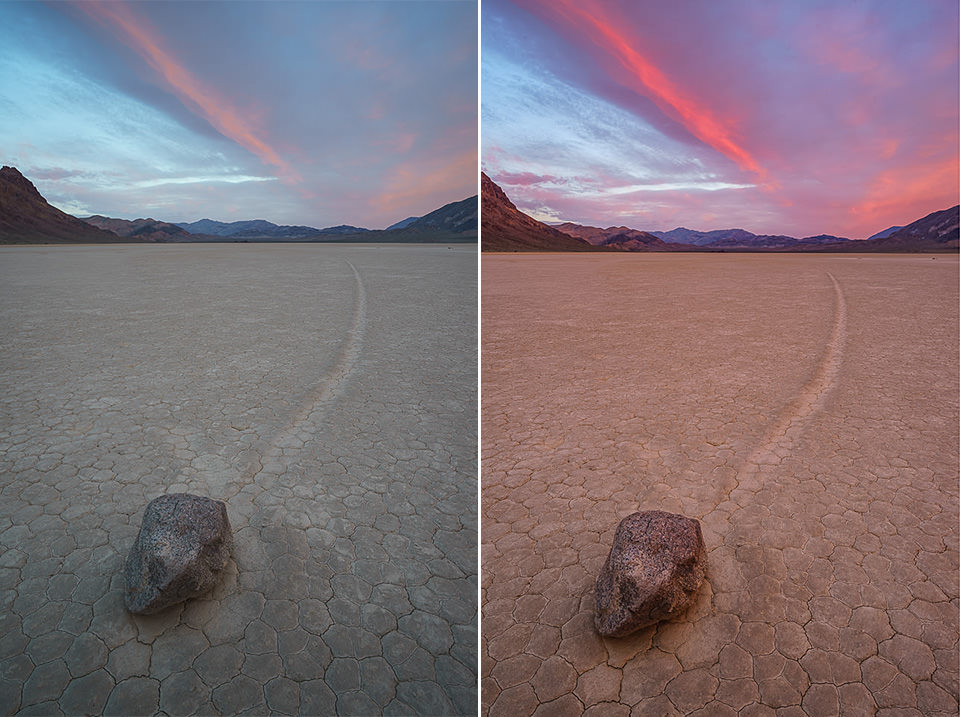
In the above case, I cropped the prototype to become closer to the stone, adapted white residual of both the foreground and the sky, added some more than color to the clouds and added a bit more structure to the clouds to brand them stand out a bit more. Later on I was done with the basic edits, I realized that some of the footsteps on the playa left by other photographers looked rather distracting. I used Photoshop's clone postage stamp tool to remove some of the obvious spots, to keep the scene looking cleaner and not as distracting.
Here is another ready of images from Wadi Rum that I captured last year to illustrate the betoken of what I consider to exist acceptable in terms of post-processing:
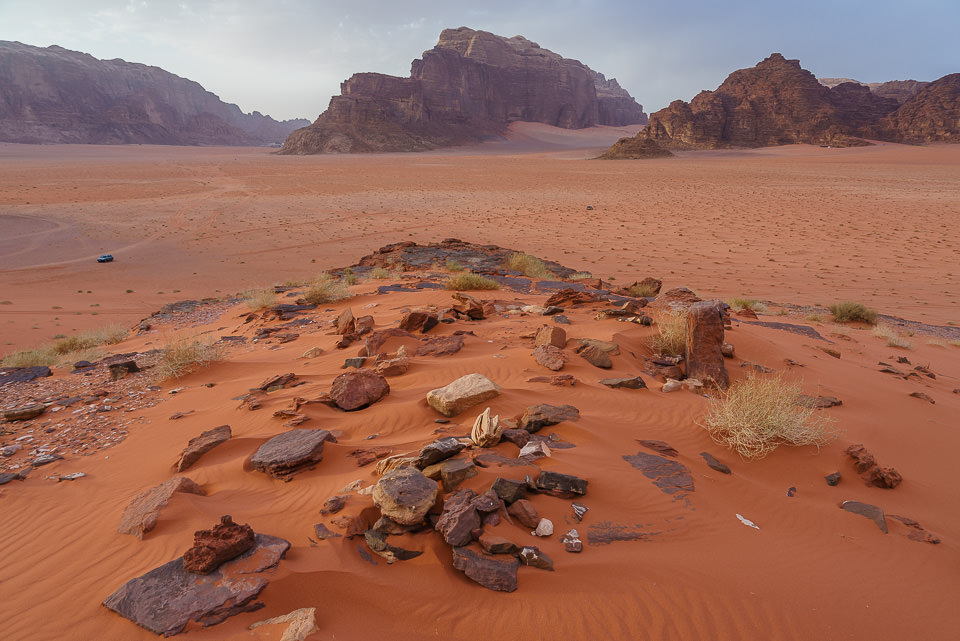
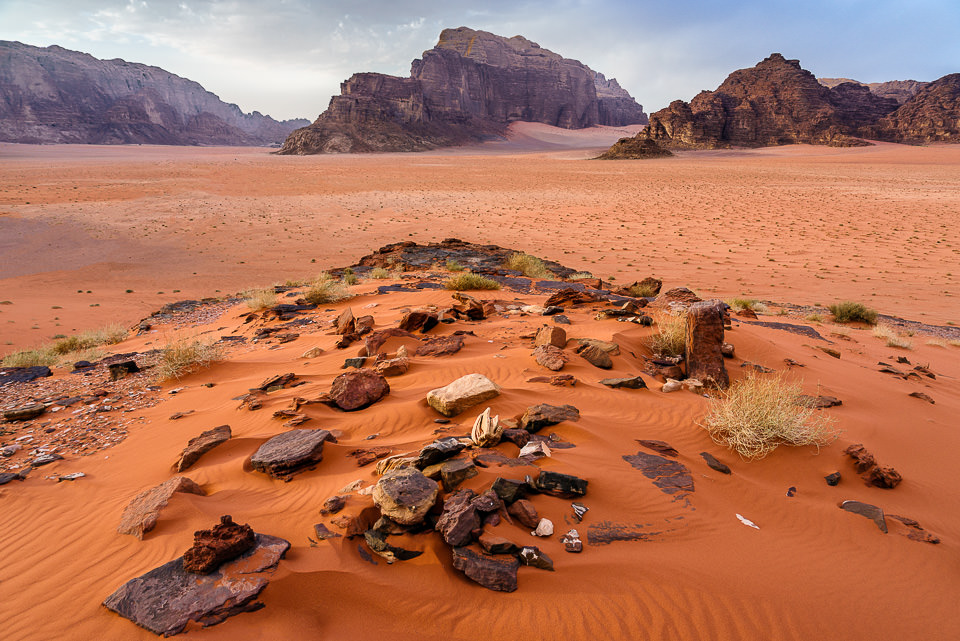
The changes in the "after" paradigm are a bit more than aggressive than in the previous case. Aside from the standard editing steps like boosting contrast and colors, I removed both cars and their tracks from the scene, since they looked too distracting. While I did not brand too many changes to the foreground, I did remove a couple of distracting elements at that place – take a look at the white stone in the foreground, to the bottom left side of the frame. When I was shooting at that item location, I was literally jumping between rocks in order not to leave any footsteps and actually struggled to find an area that provided me a clear composition. Equally I was taking this photograph, I already knew that the stone on the lower left had to get, because it was incomplete and information technology was pushing too far to the lesser frame. I was able to fit the nighttime stone on the left, but the white ane was too big to fit (you merely see a portion of information technology in the shot). Every bit I went through the image, I also removed some white dots and other imperfections in the sand, since they looked a bit distracting.
Now that yous have seen the type of editing I personally consider adequate, let's talk near the editing practices that I would not recommend. Basically, any kind of blended imagery, particularly ones where multiple unrelated images are put together to create a dramatic scene that never actually existed or took place, is something I consider unacceptable. Those photographs, or rather "artworks" practice not belong in nature photography or fine art galleries – they have a identify of their own. Nothing incorrect with such artistic photography / composites, equally long equally it is made obvious by the photographer, either through the image itself, or as part of its clarification. Over again, the idea is not to mislead people in believing in something that does not exist.
Another big factor in ethics in our involvement, influence and bear on on nature every bit we certificate it. Nosotros have written quite a bit well-nigh this topic in the by, but sadly, it is something that continues to happen. When I was at the Death Valley National Park simply a few weeks back, I saw an interesting scene – a young couple took their motorcar way into the Devil'southward Cornfield for ane stupid reason – to take a selfie. Sadly, people practice these kinds of idiotic things all the fourth dimension, thinking that they are doing something cool, when in fact, they are destroying the mural for others to see and enjoy in the future. I have personally witnessed people camping ground at the Race Rail playa at Death Valley, and I accept seen rocks removed from the playa, with the selfish intent of having unique images that nobody else could take. We have seen Michael Fatali fire upwardly Frail Curvation and a few other spots in Arches and Canyonlands National Parks to capture unique photos at dark and non but for himself, just also for the workshop groups that he was teaching at the time. And there are many cases similar this that we meet over and over again, with photographers doing all kinds of damage to landscapes, all with the goal of doing something unique that was not washed before. Such acts of vandalism and selfishness are huge problems of our fourth dimension, since nosotros are failing to learn how to share the beauty around the states with the current and future generations.
For more data about ethics in nature photography, I would recommend to visit NANPA's website. You will notice a wealth of information in regards to ethical practices when shooting in the field.
3.4) Travel Photography
There are many ethical concerns when it comes to travel photography. Unfortunately, in that location are no set rules or guidelines that apply to all countries, or cultures, tribes, groups and individuals within them. I believe that nosotros every bit photographers should do prior inquiry about the cultures, religions and other social norms before making decisions on who or what to photograph. Not abiding to very specific rules provided by government government in countries like Northward Korea could hands country you in jail at that place, and if you were to photograph people in particular areas of United mexican states where they perceive photographs as something that steals their souls, you could easily go far problem. Local laws, rules and norms should always exist respected and we as photographers hold responsibleness in properly representing all other photographers. If some of us sneak in and interruption the rules, it will surely affect the rest of us.
Accept the recent instance of a German teenager, who climbed the Peachy Pyramid of Giza, completely ignoring the Egyptian law that specifically prohibits it. Climbing ancient structures in Arab republic of egypt is prohibited for a number of reasons. First, it is very dangerous. Over the course of many years, the stone blocks accept been eroding and collapsing, and many tourists have died or injured themselves while attempting to climb in the by. 2nd, those sandstone blocks are not as strong every bit they seem to be from a altitude – imagine what will happen to those pyramids if everyone continues to climb them. In that location will be nothing left for future generations to meet and enjoy.
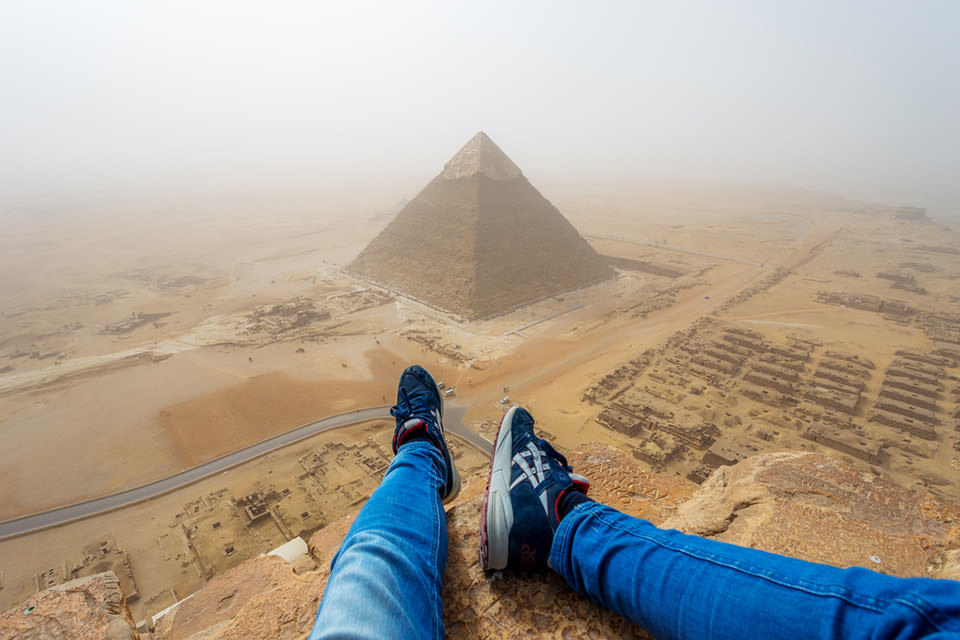
People have been vandalizing ancient structures like this for many years and nosotros can clearly see the evidence today. Even on top of Giza, you will notice carvings in dissimilar languages from people who wanted to leave their own traces of history. What a selfish agglomeration! I personally have trivial respect to daredevils like this, who break the law to promote themselves. The same goes for rooftoppers, who only do what they practise for the act of cocky-promotion, condition and social media "likes". Most of them have zero respect for laws, regulations, private property or privacy – they are known to break locks and walk into airtight areas.
Aside from the to a higher place cases, there are many other ethical factors nosotros take to consider when doing travel photography. Is it permissible to photograph people for money? You have probably seen pictures of fishermen with cormorants in boats, with lamps in their hands and beautiful afar mountains in the background. Practically every single one of those photos is staged. In fact, there is at present a whole regular army of these fishermen, ready to model in substitution for money. That expanse of China where the photographs are taken, practically has no fish left due to over-fishing and pollution, so the traditional culture of cormorant fishing just exists today for photographic reasons. So is it upstanding for us to use such practices? I cannot reply this question, simply one must recall about both pros and cons of such actions and how they affect people. Information technology has become common in many parts of the world to pay people in exchange for taking their pictures. In some popular tourist hotspots, people can be offended and even become aggressive, if you snap their photos and forget or refuse to pay them.
What about asking for a permission before taking pictures? This applies to all kinds of portrait photography, especially street photography. Is information technology acceptable to accept pictures of people without asking their permission, especially if the goal is to profit from sale of such images?
If one explores the inner world of travel photography, there are a lot of dark stories to tell and hear. I in one case heard a horror story of photographers paying children to pose naked in front of a camera (picture immature monks showing their private parts), once again, for the sole purpose of capturing something unique nobody has previously photographed. I felt disgusted and saddened to hear of such stories.
iii.5) Drone Photography
In the past few years, drone photography has been really taking off. Photographers and videographers are using drones to capture unique footage from angles and distances that are impossible to capture otherwise. While the idea of drone photography (run across our detailed tutorial) sounds appealing to many, it does bring up a few, rather serious concerns.
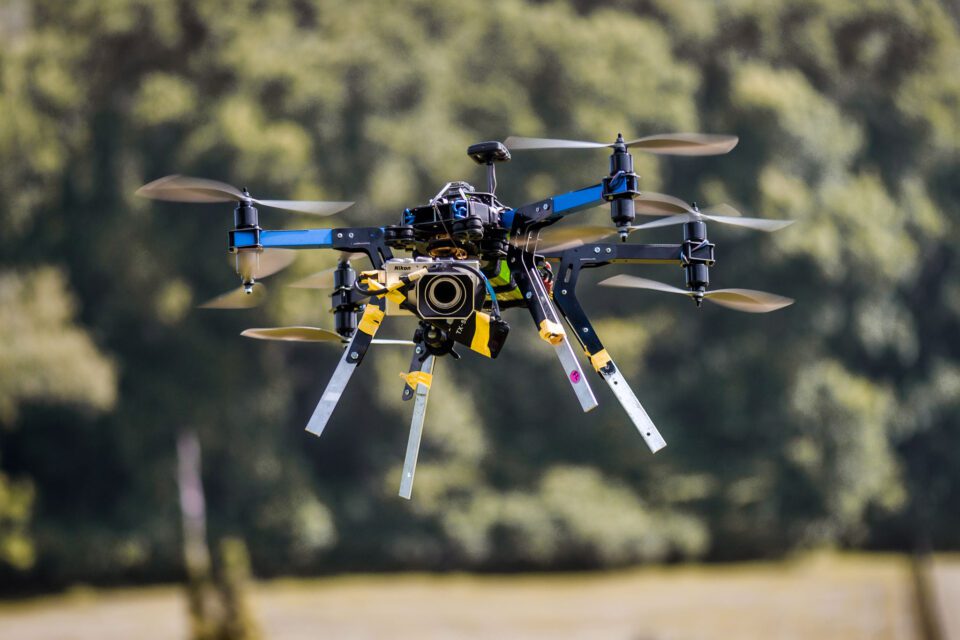
Drone photography is something very new and largely unregulated. Although after a number of cases of drones posing threat to passenger and authorities shipping, falling into protected areas (remember the guy who crashed a drone into the Grand Prismatic Spring in Yellowstone?) or crashing into buildings, the Federal Aviation Assistants of the USA made information technology mandatory to register drones. Bated from basic guidelines, there are nevertheless no specific laws or rules in regards to how drones should be operated. This has been creating a huge problem for anybody, because people are making all kinds of assumptions almost what they tin and cannot do. Nada is said about flying over private property, privacy concerns and recording footage of people or their holding. Things are getting fifty-fifty more complex overseas, where governments and people never had concerns of shipping flying over their heads and now they find themselves in dire need of protecting their landmarks and secure zones from tourists operating drones.
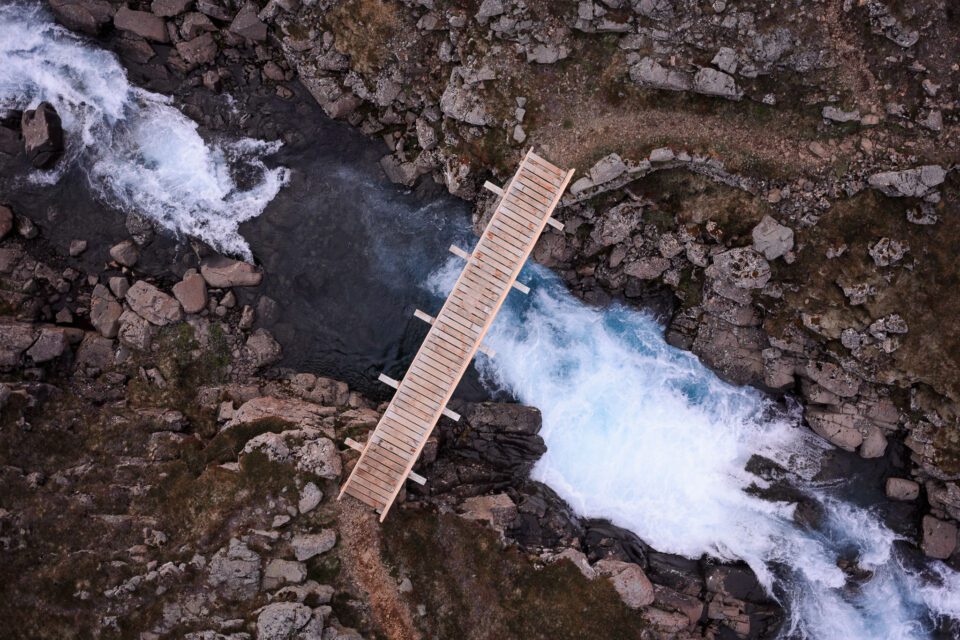
Seyðisfjörður, East Republic of iceland. Photograph Copyright Spencer Cox
Sadly, many owners operate their drones without much practice, crashing them into government and private properties. Since drones cost a lot of money, they oft terminate up breaking into airtight areas and trespassing in social club to call back them, causing all kinds of aggravation from the public.
There are many ethical concerns with drone photography and I believe that this subject should be explored in item, as information technology will become more than important with the growing popularity of drone photography.
4) The Ideals of Photography Competitions
Photo competitions historically have had rather odd ready of rules, often disallowing whatsoever kind of post-processing on images. Some do not allow whatever retouching, while others let very slight changes involving color and dissimilarity adjustments and perhaps some cropping. While I disagree with "no editing" rules of competitions and believe that some editing to images should be allowed, I would certainly disagree with rules assuasive whatever kind of editing and photo manipulations. Once you go into the "free for all" zone, photograph competitions can speedily lose their appeal. There are some real Photoshop wizards out there, who will make stunning-looking images from images that others would consider below average. A petty scrap of imagination and Photoshop cartoon skills tin really bring something that never existed or took place into life. That's not to say that such composites and artwork should not be immune at all, but those should be judged separately on their own, away from photography competitions.
Consider the recent example of Chai Yu Wei, a photographer from Singapore, who not simply borrowed another lensman's idea to capture a ladder leading upward to the sky, but too had the guts to insert an airplane to the eye of the image before submitting it to a competition hosted by Nikon. Sadly, when asked, he even claimed that he was lucky to capture the plane similar that. It did not have much time for other photographers to discover that the photo was a fake:
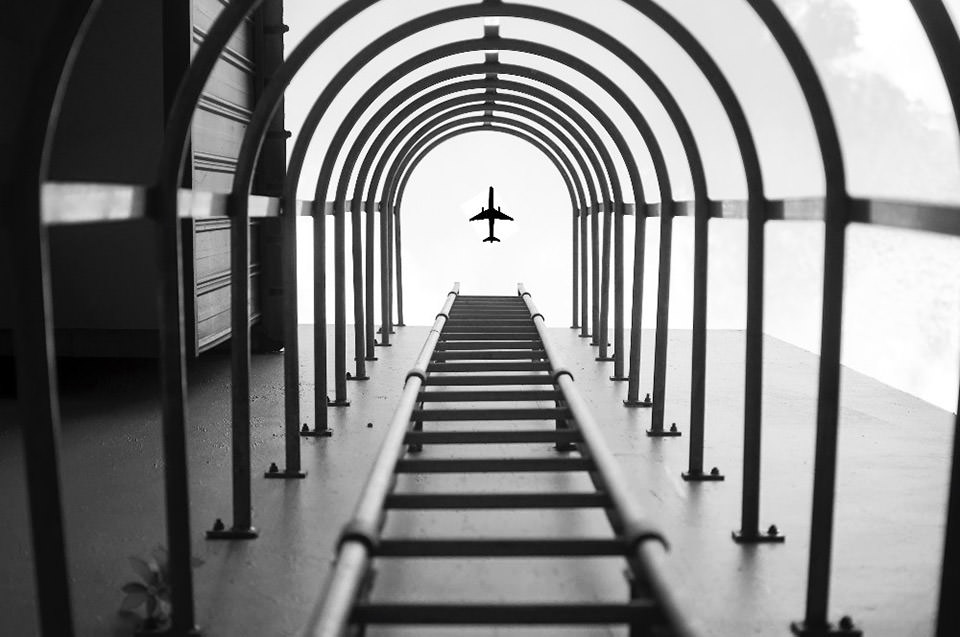
Nikon concluded up removing the photograph from its Facebook page and apologizing for selecting the photo as the winner, and the photographer issued an apology besides. However, this detail case volition serve equally another reminder on why photo manipulations like this should not exist allowed. Chai Yu Wei wanted others to believe that he was at the right moment and at the correct place to capture a photo of a plane passing past correct through the center of the leading composition, something that obviously never took identify.
The aforementioned upstanding guidelines apply to wild animals photography competitions as well. We have seen a instance where the photographer José Luis Rodriguez captured a photo of a wolf jumping over a contend, stating that the prototype portrayed a existent wild wolf that was hunting farmer'south livestock:
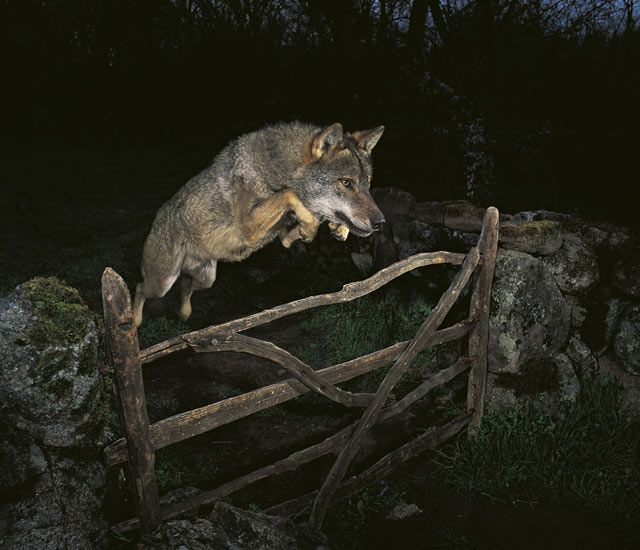
It turned out that the wolf was in fact not wild and the photographer basically staged a tame wolf to jump over the contend, while he captured it with flash at night. While this particular image was not a composite and was not edited every bit the previous image, it has a huge ethical problem – lying virtually an animal being wild, when it is not. If photographers are allowed to stage tame animals for wildlife competitions, then there is no point of photographing wild animals at all: one could capture stunning images of domesticated and tame animals, with some beautiful backgrounds.
v) The Ethics of Feeding Wildlife
There are cases where some wildlife photographers might get upset with other photographers, who might not necessarily use a tame or a domesticated animal equally in the instance above, but might feed a wild animal in society to capture unique shots. Many wildlife photographers practise such feeding procedures and take no guilt in doing that – some of them are quite open nearly it as well. Whether it is setting upwards bird feeders in the backyard, or putting mice in fields for those awesome shots of predators flying towards the camera, the question of whether those acts are ethical or non come up all the time between wildlife photographers. I will exit this one upwards for discussion: Exercise you recall it is adequate for photographers to feed wildlife to capture unique shots? Are at that place cases when such practices should exist allowed?
Source: https://photographylife.com/the-importance-of-ethics-in-photography
0 Response to "Few Fine Art Photographs Are Sold Today True False"
Postar um comentário